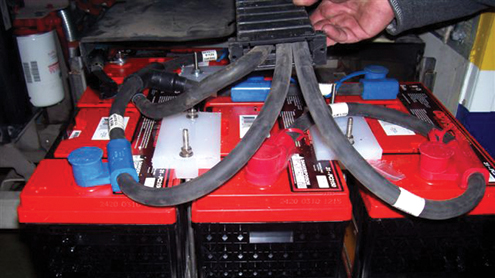
BCI Group 31 AGM-VRLAs
By Kalyan Jana
Diesel engines used in commercial vehicles such as transit buses and motorcoaches generally require a heavy-duty 8D lead-calcium 12-volt, six-cell acid battery for starting. The 8D designation is in accordance with standards set by the Battery Council International (BCI), Chicago, IL, a trade association promoting the interests of the lead-acid battery industry. BCI is recommending the BCI Group 31 absorbed glass mat, valve-regulated lead-acid (AGM-VRLA) battery as a substitute for the 8D lead-calcium acid battery.

The sealed BCI Group 31 AGM-VRLA battery eliminates the need to refill the electrolyte and prevents corrosion of the positive terminal and surrounding area, leading transportation operations in the United States and Canada to convert from the conventional BCI Group 8D lead-calcium flooded-electrolyte battery.
The ODYSSEY® 31-PC 2150 from EnerSys, Reading, PA, is such a battery, named for the 2,150 amps it delivers in five seconds. PC stands for pulse crank in an engine cranking application. The design of an AGM-VRLA battery eliminates acid spills, which helps improving the overall level of fleet safety. The company says this battery properly charged will deliver 400 cycles to 80 percent depth of discharge (DOD).
In 2006, Burlington Transit, Burlington, ON, Canada, became the first convert in Ontario to the 31-PC 2150 following a fire in the engine compartment of one of its 40 transit buses. The city council mandated the agency to convert to safer batteries. Burlington Transit was the first company in Ontario to use this battery.
According to John Giordano, a consultant for Great Northern Battery Systems, Hamilton, ON, Burlington Transit tested this battery on two buses for nearly a year, which led to changing the batteries on the existing fleet of 40 buses to the Odyssey batteries, as well as specifying 31-PC 2150 batteries for all new buses. Giordano says Ottawa City Transpo has retrofitted about 1,300 buses with Group 31 AGM-VRLA batteries. In the U.S., Metro Transit in King County, WA, converted to Group 31 AGM batteries in 2008 after a period of preliminary testing.

“We’ve found the Group 31 AGM batteries have a longer life and a greater reserve capacity,” says George Stites, superintendent of Fleet Engineering, King County Metro Transit. “These batteries have a higher cold cranking amps (CCA) rating. The dry-cell design is better. Being sealed, gases do not escape, making them safer to use. There’s also no corrosion on the battery trays.”
Another benefit of this battery is its excellent performance with parasitic loads, created when electronic devices such as communications equipment draw energy from the same battery used for starting, lighting and ignition (SLI) functions. Typically, the small current drains from parasitic loads will deeply discharge an over-discharged battery that has been out of operation for a while.
Conventional batteries such as the BCI Group 8D lead-calcium battery do not recharge as the BCI Group 31 AGM-VRLA. For example, four 12V Odyssey 31-PC 2150 batteries inadvertently over-discharged and left in that condition for at least three weeks, showed a reading of the open circuit voltage (OCV) between 5.0V and 5.6V. All four batteries recovered by simply charging for 16 hours at 14.7V. It is highly unlikely a conventional lead-calcium battery would recover.
This battery’s capability to power both parasitic loads and SLI functions effectively led two Canadian bus manufacturers to install BCI Group 31 AGM-VRLA batteries, in place of the BCI Group 8D lead-calcium batteries.
BCI Group 31 AGM-VRLA batteries can withstand harsh shock and vibration conditions. The Odyssey 31-PC 2150 battery also operates at temperatures as low as minus 40 degrees Fahrenheit (minus 40 degrees Celsius) and as high as 176 degrees Fahrenheit (80 degrees Celsius). A variety of tests, such as those specified in the Caterpillar 100-hour test, the U.S. Navy’s MIL S- 901C test and the International Electrotechnical Commission (IEC) 61373 standard have validated these characteristics. BR
Kalyan Jana serves as project manager for AGM batteries for EnerSys, Reading, PA.
